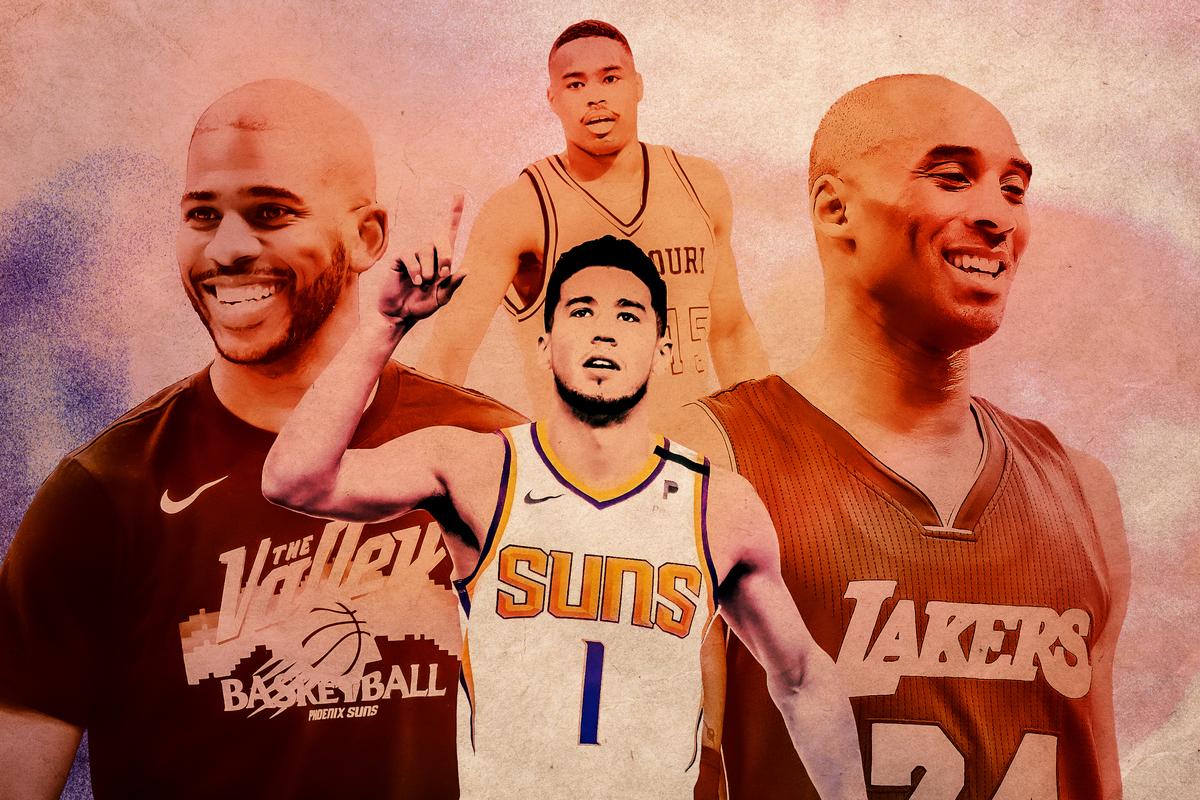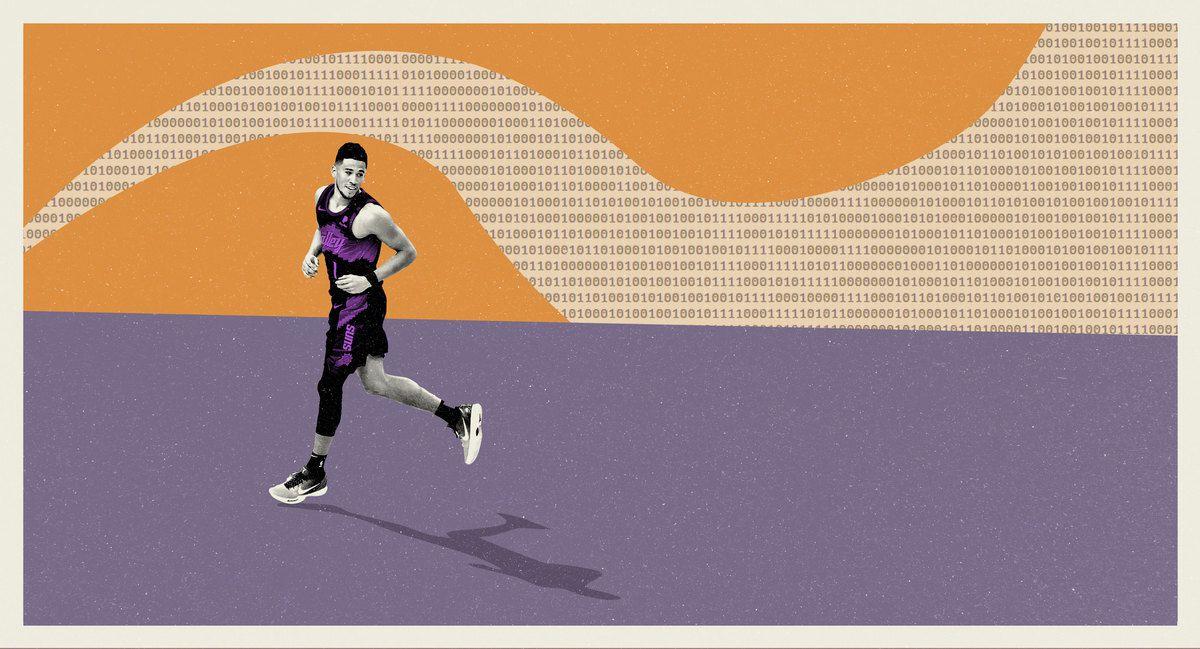
The help comes between Booker and the rim like a wall, forcing him to decelerate as if he were coming up to the edge of a cliff. Narrowly avoiding disaster, he floats between the rim and the 3-point line and pauses, freezing his defender, offering the illusion that for a split second, he has control over the game’s uncontrollable churning. Then he picks up the ball, pump fakes, draws a foul, and nails the floater. And-1. Now he’s playing the hits: squeezing through a trap like he’s escaping a closing elevator, floating in the air and hitting a bank shot from the left block; nailing stepback after stepback.
Melvin Booker, who looks like an older, stockier version of his son, finished this pro-am run in 2018 with 25 points in the first half. Devin has ridden those same moves to an NBA Finals run that could end Tuesday. Booker has racked up 82 points in his last 80 minutes, but the Suns have still lost their last three games. Now they face a 3-2 deficit against the Bucks, who they’ve yet to beat on the road.
Devin Booker has many influences. I know this because this is how he frames his development, pulling up to NBA Finals games in vintage Suns T-shirts, paying homage to past legends, creating a mind map of all the people who’ve impacted him. But none have left a stronger stamp than the first: his dad, Melvin, a former pro baller who followed the ball where it bounced, from Missouri to Moscow to the NBA.
When Melvin was a kid, his father dominated playgrounds and rec leagues all over Moss Point, Mississippi. Melvin carried his dad’s bags from game to game, cheering him on. “I ain’t going to say a local legend, but he was one of the better guys in our area,” says Melvin. “It’s what made me fall in love and develop my own passion for the game.”
Devin spent his summers in Moss Point, hopping in drills, fetching rebounds, running around the court imitating his dad’s every move. “He always competed at the highest level,” says Devin. “And I think that rubbed off on me a little bit.”
Melvin’s dad played basketball, Melvin played basketball, so it was only natural that Book would play too, as though he were taking over the family restaurant. “A lot of kids, a lot of families, don’t know what it takes and the time that it takes to get to this level and the sacrifices that you have to make,” says Melvin. But Melvin had the recipe, refined through generations.
Booker credits his dad for teaching him to have a short memory, a key ingredient for every unconscious scorer. He credits Tyson Chandler for helping him see the lessons in those early losses, back when the Suns were putting him through, in his own words, a lot of “bullshit.” He credits Chris Paul, Jae Crowder, and Monty Williams for preparing the young Suns for the playoffs, alongside his basketball heroes, Kobe Bryant and Rip Hamilton, who he watched growing up.
Booker talks like he knows he’s standing on the shoulders of giants, and when he plays, his game looks like an homage to NBA history.
After closing out the Lakers with 47 points in Game 6 of the first round, he looked up at the 8 and 24 in the rafters and thought about Kobe. “Honestly, I was thinking about Kob and the conversations that we had about what we just went through, the postseason and being legendary and taking the steps to get there.”
When he broke his nose against the Clippers in the West finals, he sought Rip Hamilton’s advice and asked if he should wear a mask.
Ask Booker about his ability to withstand the Bucks’ and P.J. Tucker’s physicality, and he’ll credit, well, P.J. Tucker. Back in 2016, Tucker was the old head on the Suns. Booker picked up Tucker’s toughness through osmosis, through bumps and bruises that forced him to raise his level of physicality at every practice. Booker responded to that physicality with even more physicality, upping the ante until the two almost came to blows.
Booker’s game makes more sense when you consider the Kobe and Rip influences more deeply. The two just weren’t contemporaries; they were friends and rivals, polar opposites at the shooting guard position. Hamilton’s Pistons, Booker’s favorite team growing up, beat the Lakers’ bloated superstar lineup with defense and connectedness in the 2004 NBA Finals. Kobe was a symbol of double-clutching, fuck-your-doubleteam heroism, and Hamilton sprinted off the ball and ran complex routes through screens just to get open, long before Klay Thompson made it cool. But Booker’s offensive game is a surprisingly fluid amalgamation of them both.
Booker can score at will. He thrives in movement and isolation, in half court and transition. He can also recede into the background and come off screens while someone else handles the ball—like he did at Kentucky, where he came off the bench, and like he does now alongside Chris Paul, allowing the Suns to combine the 2017 Rockets’ isolation-heavy plodding with movement and pace reminiscent of the Tim Duncan–era Spurs, where Suns coach Monty Williams was once an intern coach.
For some reason, discussions about NBA legends often take on the air of a negative ad campaign. By the end of every debate—and it always turns into a debate—everyone is left with a bad taste in their mouths. But Booker reframes the legends of the past as influences as opposed to enemies.
Comparing Booker to his mentors allows us to see how the game has changed: Booker has more range than Bryant did, but Bryant was stronger getting to the rim, and he was also a much better defender.
To watch Booker come off screen after screen is to understand just how sizzling a scorer Hamilton could have been in 2021. It is also to know that Hamilton would have had to work on a host of other things aside from his shooting.
Booker is ahead of both as a playmaker, a reflection of a LeBron-ified league in which the leading man must be able to do everything with the ball. That’s why, alongside ripping off screens and nailing daggers, Booker snakes into the lane, puts defenders in cages, and throws precise lobs like Paul.
Booker studied the best of the early aughts and filtered it through his own sensibilities and the requirements of the modern NBA, allowing us to see what’s ancient, what’s changed, and what is quintessentially Devin Booker: patterns that he’s repeated so often they’ve become etched, rep by rep, into his personal style. The lefty teardrop floater over Brook Lopez’s outstretched hands. The left-handed layup off his right foot. The wraparound left-handed passes from the right block. The way he makes himself smaller in the corners, giving himself a few extra inches to create space to pump fake, step back, and create a corner 3 off the dribble. By losing himself in everyone else’s games, he has found moves that are uniquely his.
When I feel shipwrecked, a phrase in the Nanak Naam translation of the Japji Sahib, the introduction to the Guru Granth Sahib, brings me back to shore. Its core tenet, that none of us really exist outside the collective, is driven home by Bhai Satpal Singh, who asks: How can one drop of water hope to understand the ocean?
The phrase is a calming tranquilizer, a reminder that we are all really so small. When I think about it, I think about the hollow insides of a tree trunk lined with sap, ancient history lined by what’s just being born, erosion alongside preservation. I also think about Devin Booker, because even his most devastating individual performances feel like an homage, a reminder that he is just one star among a galaxy of others who have come to pass, and more who are coming, that no matter how pretty the teardrop, it’s just one shot in a long arc.


